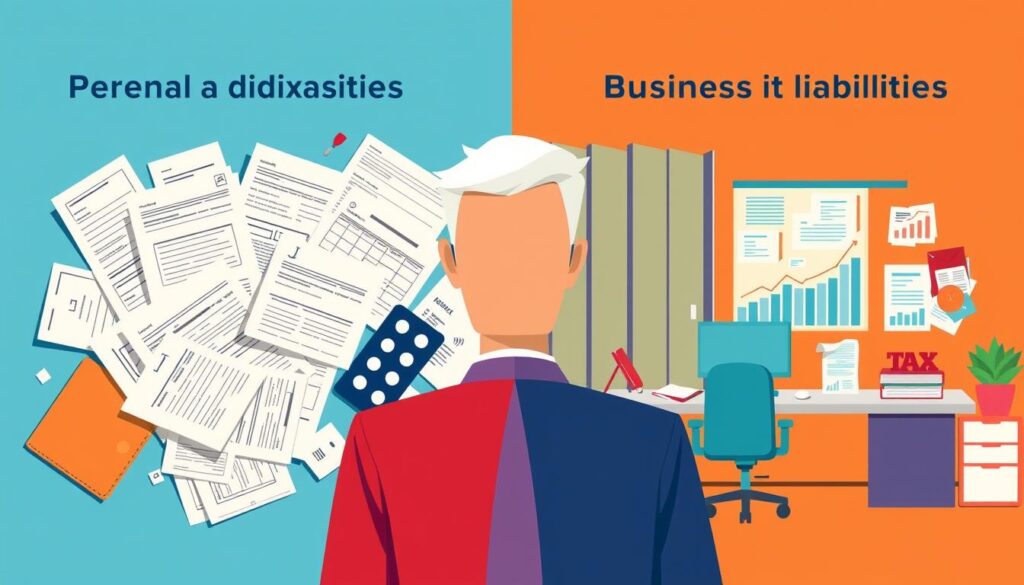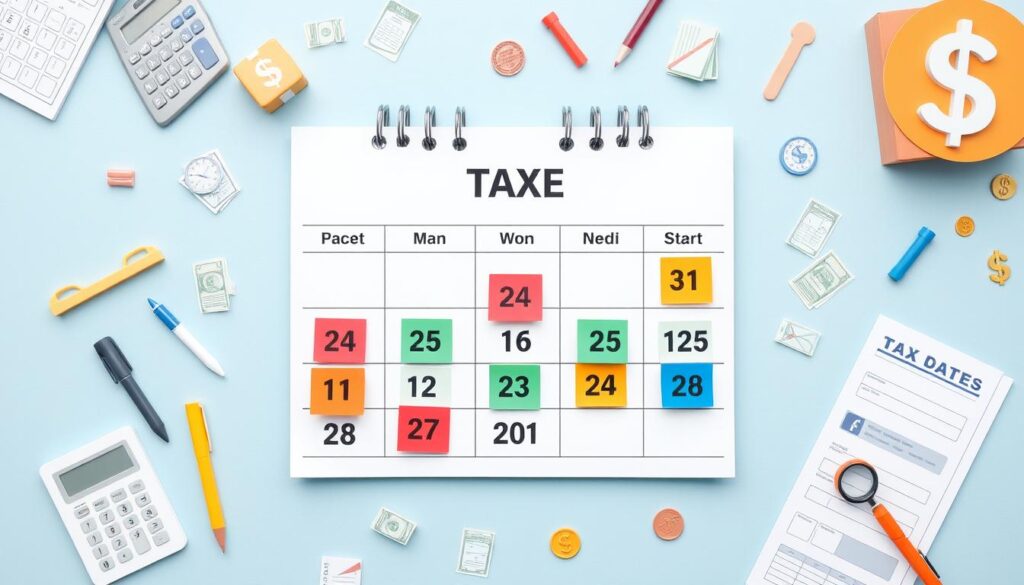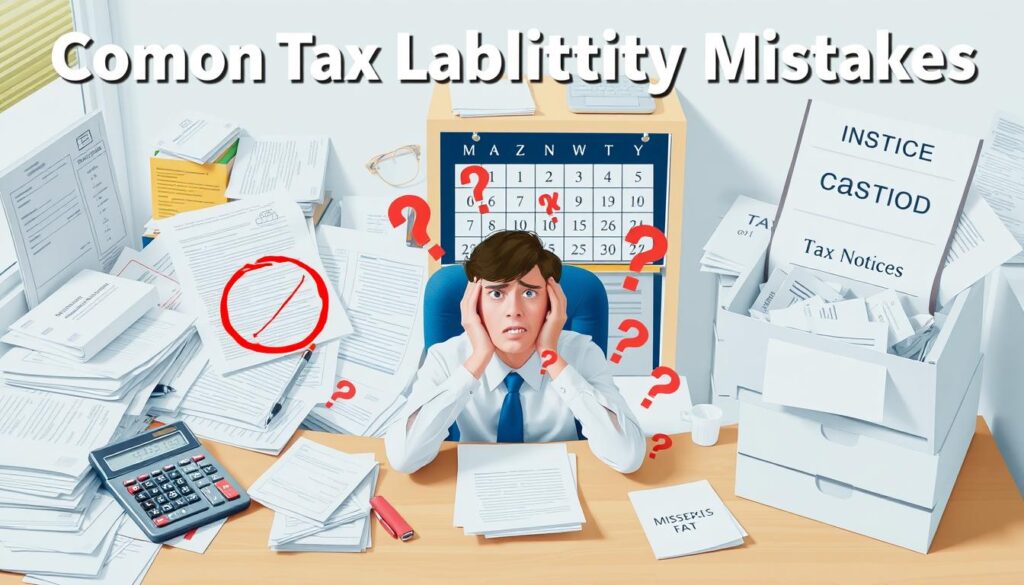Have you ever felt that tight knot in your stomach when tax season approaches? You’re not alone. Many share an unspoken anxiety about managing tax liabilities, a responsibility that seems to loom larger every year. Understanding tax obligations can feel overwhelming, with myriad calculations, potential deductions, and complicated brackets thrown into the mix. Yet, grasping the essentials can transform that apprehension into confidence and clarity. In this guide, we’ll break down key concepts to help you navigate your IRS tax liabilities more easily, empowering you to make informed decisions and take control of your financial future.
When it comes to tax liabilities, knowledge is your best ally. From familiarizing yourself with the definition of these obligations to understanding who is responsible for them, this guide aims to simplify the complexities of taxes. With the average individual in the top 50% income bracket paying around 14.82% or more of their income in federal taxes and 97% of all income taxes in the U.S. coming from roughly half of taxpayers, staying informed is essential1. Let’s dive into the essentials of tax liabilities and equip you with the tools needed to manage them effectively.
Key Takeaways
- Tax liabilities refer to the total amount of tax owed to federal, state, or local governments.
- Standard deductions can reduce your taxable income significantly, such as $14,600 for single filers in 2024.
- Understanding tax brackets is crucial, as they dictate how much you owe based on your income level.
- It’s essential to recognize that both individuals and businesses have tax obligations, which can vary widely.
- Various deductions and credits exist that can significantly lower your tax liabilities.
- Staying updated on deadlines will help you avoid penalties and ensure timely payments.
- Working with tax professionals can unveil strategies to optimize your tax situation effectively.
What Are Tax Liabilities?
Understanding tax liabilities is crucial for managing your finances efficiently. A tax liability is simply the total amount of taxes you owe to a government entity, such as the IRS. This encompasses various obligations, including federal income tax, state income tax, property tax, and sales tax. Each type of tax has its unique calculation method and impacts the definition of tax liabilities.
Definition of Tax Liabilities
Tax liabilities arise when you have taxable income or profit from asset sales. The federal corporate income tax rate for C Corporations is 21%, reflecting one of the common tax liabilities for businesses2. For individuals, the federal income tax system is progressive, meaning that your tax rate increases with higher income brackets, reflecting different rates applicable to different levels of income3. Knowing your tax liabilities helps in planning payments and avoiding potential tax debt.
Common Types of Tax Liabilities
Various tax liabilities exist, with each serving a specific purpose within governmental funding. Below are some of the common types:
- Federal Income Tax: Based on income levels and brackets.
- State Income Tax: Varies by state; for example, Utah has a state income tax rate of 4.95%3.
- Property Tax: Based on the assessed value of your property, which may vary considerably.
- Sales Tax: Typically varies depending on location and the nature of the goods sold.

When calculating your overall tax liability, it’s important to account for deductions and credits that can lower your owed taxes. For instance, for the 2023 tax year, single filers can claim a standard deduction amount of $13,8504. Understanding the various elements involved in tax liabilities assists in making informed financial decisions and ensures compliance with tax regulations.
| Type of Tax Liability | Description |
|---|---|
| Federal Income Tax | Tax owed on income earned; progressive rates apply. |
| State Income Tax | Tax owed on state income; varies by state. |
| Property Tax | Tax based on property valuation; can vary widely. |
| Sales Tax | Tax on goods and services purchased; rate varies by region. |
This information reinforces the necessity of staying vigilant about tax obligations and planning accordingly to mitigate tax debt in the future4.
How Are Tax Liabilities Calculated?
Understanding the process of calculating tax liabilities is vital for effective financial planning. Various elements come into play, most notably tax brackets and the role of deductions and credits. When you begin calculating tax liabilities, it is essential to recognize that tax brackets categorize income, determining how much you pay in taxes on different portions of your income.
The Role of Tax Brackets
Tax brackets represent tax rates applied to specified income ranges. For the 2023 tax year, here are the federal income tax rates and brackets for single filers:
| Tax Bracket | Income Range | Tax Rate |
|---|---|---|
| 10% | $0–$11,000 | 10% |
| 12% | $11,000–$44,725 | 12% |
| 22% | $44,725–$95,375 | 22% |
| 24% | $95,375–$182,100 | 24% |
| 32% | $182,100–$231,250 | 32% |
| 35% | $231,250–$578,125 | 35% |
| 37% | Over $578,125 | 37% |
To illustrate, if you have a taxable income of $46,150, your tax liability would be calculated using the above brackets, totaling $5,460.50 after considering the different rates applied at each level5.
Deductions and Credits Explained
Deductions and credits play a significant role when calculating your net tax liability. Standard deductions for the 2023 tax year are $13,850 for single filers and $27,700 for married couples filing jointly5. Contributions to tax-deferred accounts such as a 401(k) can reduce your taxable income, resulting in lower tax liabilities.
Tax credits further reduce the total tax due by providing a dollar-for-dollar reduction against your tax bill. Utilizing both deductions and credits can substantially enhance your ability to reduce tax liabilities effectively. Common examples include expenses related to business operations, such as equipment, office rent, or advertising costs6. Seeking professional advice can help identify additional deductions and credits that apply to your specific situation, ultimately optimizing your tax strategy.

Engaging with tools and professionals dedicated to optimizing tax processes may prove invaluable as you navigate the complexities of tax obligations.
Who Is Responsible for Tax Liabilities?
Understanding who holds tax responsibilities is vital for effective financial planning. Both individuals and businesses face distinct obligations that influence their financial health. The differentiation in tax liabilities can become clearer when recognizing the roles each entity plays.
Individual vs. Business Responsibilities
For individuals, managing personal tax liabilities is straightforward but essential. Each person is responsible for income tax, self-employment tax, and potential penalties and interest on past-due amounts. Notably, corporate officers and key individuals within a business can inherit trust fund tax liabilities, which affect their personal finances as well7. Business tax liabilities encompass varied responsibilities, including payroll taxes withheld from employee wages and state sales taxes collected from customers7. In total, businesses must account for several types of taxes, from income tax to additionally complex trust fund taxes, held until the corresponding tax return is filed8.
Understanding Joint Filers vs. Single Filers
The choice between joint vs single filers impacts tax payments significantly. Generally, joint filers benefit from higher income thresholds in tax brackets; for example, a married couple filing jointly may access a standard deduction of $27,700, unlike single filers who receive $13,8508. Joint filing enables couples to often lower their overall tax liabilities and maximize eligible deductions, which can include child and dependent tax credits8. For those considering their debt levels, both individuals and businesses must recognize that unpaid tax liabilities can affect future financial opportunities, such as obtaining loans9.

| Responsibility Type | Examples | Implications |
|---|---|---|
| Individual Responsibilities | Income Tax, Self-Employment Tax | Direct impact on refunds and liabilities |
| Business Tax Liabilities | Payroll, Sales Tax | Can affect loan approvals and operational viability |
| Filing Status | Joint, Single | Varied tax brackets and deductions applied |
Key Factors Affecting Your Tax Liabilities
Your tax liabilities can be influenced by various factors, including your income level and residency status. Understanding these key factors tax liabilities can help you navigate your obligations effectively.
Income Level Considerations
The first thing to take note of is how your income level tax affects your overall tax liabilities. Higher earners typically find themselves in elevated tax brackets, leading to increased taxes owed. For example, in 2023, different individuals would pay vastly different amounts based on where their income falls within these tax brackets, underscoring the importance of knowing where you stand10.
Residency Status and Tax Implications
Your residency status implications can further complicate your understanding of tax obligations. States impose varying tax rates, with some states enforcing no income tax at all, while others may have significant tax burdens for residents. These variations mean that where you choose to live can drastically impact your total tax liabilities. For instance, understanding the tax landscape in your state can potentially save you money each year

| Residency State | Income Tax Rate |
|---|---|
| California | 1% – 13.3% |
| Texas | No Income Tax |
| New York | 4% – 10.9% |
| Florida | No Income Tax |
By keeping these factors in mind, you can make informed decisions regarding your financial planning and tax strategy. Understanding how income level and residency impact your liabilities may empower you to optimize your tax situation and potentially minimize overall tax burdens11.
Important Tax Deadlines You Should Know
Staying up-to-date with important tax dates is essential for managing your tax obligations effectively. Falling behind on tax filing deadlines can lead to significant penalties. As you prepare for the upcoming tax season, understanding these deadlines will help you avoid potential issues and ensure compliance with the IRS.
Annual Filing Deadlines
The calendar year brings several key tax filing deadlines for individuals and businesses. For most states, the primary tax filing deadline is April 15, 2025, with specific exceptions for Maine and Massachusetts. If you have been impacted by Hurricane Helene or Hurricane Milton, you may be granted an extension until May 1, 2025, for both filing returns and making payments. If you require extra time, you can request a six-month extension, which pushes your due date to October 15.
Estimated Tax Payment Due Dates
Taxpayers who do not have sufficient taxes withheld from their income need to make estimated tax payments regularly to avoid excess tax liabilities at year-end. For the 2025 tax year, the first estimated tax payment is due on April 15, followed by the second due date on June 16, and the third on September 15. Final payments for income earned from September 1 to December 31, 2024, are due on January 15, 2025. Businesses also have specific important tax dates, such as the deadline of January 31 for submitting W-2 forms to the IRS and employees.
| Deadline | Description |
|---|---|
| April 15, 2025 | Individual tax filing deadline |
| May 1, 2025 | Extended deadline for Hurricane Helene and Milton victims |
| October 15, 2025 | Deadline after a six-month extension for individuals |
| April 15, 2025 | First estimated tax payment due |
| June 16, 2025 | Second estimated tax payment due |
| September 15, 2025 | Third estimated tax payment due |
| January 15, 2025 | Final estimated tax payment for 2024 income |
| January 31, 2025 | Deadline for businesses to submit W-2 forms |

Common Mistakes That Increase Tax Liabilities
Understanding common tax liability mistakes helps you navigate your financial responsibilities more effectively. Mistakes can stem from various areas, leading to unnecessary stress and increased liabilities. Recognizing where missteps often occur is crucial for better tax management.
Misreporting Income
One key area where taxpayers struggle is misreporting income. Errors in reporting can stem from overlooking earnings from side hustles, freelance work, or investment gains. The intricate nature of U.S. tax statutes—over 10 million words as of 2015—contributes to confusion, leading many to make mistakes on their returns12. Misreporting can trigger penalties from the IRS, aggravating tax liabilities and complicating financial situations. Ensuring all income is reported accurately is essential for maintaining compliance.
Overlooking Deductions
Another common issue is overlooking deductions that taxpayers qualify for. Many individuals miss out on valuable deductions like business expenses and educational credits, which can significantly impact tax obligations. For example, the 2024 standard deductions range from $14,600 for single filers to $29,200 for married couples filing jointly12. Additionally, the Qualified Business Income deduction allows owners of pass-through entities to claim up to a 20% deduction of their qualified business income13. Being proactive in understanding eligible deductions can help you lower your taxable income effectively and reduce overall tax liabilities.

Strategies to Reduce Your Tax Liabilities
Finding effective strategies for reducing tax liabilities can greatly benefit your financial health. You can adopt various methods, primarily focusing on tax deductions and retirement accounts tax strategy. By using these carefully, you can significantly lower your taxable income.
Utilizing Tax Deductions Wisely
Tax deductions can play a crucial role in minimizing your tax liabilities. Consider taking advantage of charitable donations, which not only support your favorite causes but also provide income tax deductions, effectively lowering your tax burden14. Additionally, pre-tax contributions to a Health Savings Account (HSA) reduce your taxable income, aiding in your overall strategy15. Certain health expenses and mortgage interest can also be deductible, depending on your financial situation and itemized deductions16.
Investing in Retirement Accounts
Investing in retirement accounts is another smart way to implement a retirement accounts tax strategy for your benefit. Contributions to a Traditional 401(k) plan with pre-tax dollars can effectively reduce your current income and taxes owed for that year14. Similar benefits apply for contributions made to a Traditional IRA, which can lower your taxable income when you file your taxes16. Roth IRA contributions allow for after-tax growth benefits, ensuring your investment grows without future tax implications. Remember, up to $100,000 can be done through Qualified Charitable Distributions (QCD) for individuals over 70.5 years, effectively reducing your taxable income15.

Understanding Capital Gains Tax
Capital gains tax applies to the profit realized from the sale of certain assets. Understanding the difference between short-term and long-term capital gains can significantly influence your overall tax liabilities. The time you hold an asset before selling plays a critical role in determining the tax rate you will face.
Short-term vs. Long-term Capital Gains
Short-term capital gains occur when you sell assets held for one year or less. These gains are taxed as ordinary income, with rates ranging from 10% to 37% depending on your income bracket17. In contrast, long-term capital gains apply to assets held for more than a year. The tax rates for these gains can be more favorable, ranging from 0%, 15%, to 20% based on your taxable income and filing status for the 2025 tax year18
How Capital Gains Impact Your Liabilities
Long-term capital gains generally benefit from lower tax rates compared to short-term gains. High-income taxpayers, especially those with income exceeding $1 million, may face higher capital gains taxes, potentially up to 43.4% if the American Families Plan is enacted17. Additionally, while up to $250,000 of capital gains on the sale of your primary home can be excluded, this applies only under specific conditions18. Taxpayers should also consider that capital losses can be offset against gains, providing a tax strategy to minimize taxable profits. Knowing the implications of capital gains tax on your investments can lead to informed financial decisions.
| Type of Gain | Holding Period | Tax Rate |
|---|---|---|
| Short-term Capital Gains | One year or less | 10% to 37% |
| Long-term Capital Gains | More than one year | 0%, 15%, or 20% |
Impacts of Tax Liabilities on Financial Planning
Understanding the impacts of tax liabilities is crucial for effective financial planning. When you prioritize budgeting for taxes, you not only avoid surprises during tax season but also create a more stable financial foundation. By incorporating tax planning importance into your overall strategy, you can find opportunities to reduce your liabilities and increase your savings.
Budgeting for Tax Payments
Budgeting for taxes helps you forecast and set aside the necessary funds to meet your tax obligations. A comprehensive approach includes estimating both federal and state taxes to avoid year-end surprises. You should regularly review your taxable income and potential deductions to better strategize your tax payments throughout the year.
Importance of Tax Planning
Implementing effective tax planning can significantly reduce the impacts of tax liabilities on your wealth. Techniques like tax-loss harvesting can mitigate capital gains taxes by utilizing losses to offset gains elsewhere in your portfolio19. Furthermore, establishing trusts or employing gifting strategies can minimize estate tax liability19. A strategic tax plan not only maximizes investment returns but also preserves wealth efficiently, which is vital for long-term financial health19.

How Tax Liabilities Differ by State
Understanding the variation in tax liabilities by state is essential for effective financial planning. Each state has its unique approach to taxation, influencing your overall state tax liabilities.
State Income Taxes Explained
Some states impose a flat income tax rate, whereas others have graduated rates that increase with income. For instance, California leads in individual income tax collections with an impressive $3,729 per capita, followed closely by Connecticut at $2,845 and Massachusetts at $2,81820. States without a personal income tax, such as Texas and Florida, appeal to many looking to minimize tax liabilities by state20. It’s also important to note that Oregon applies a tax rate of 9.90% on income over $125,000 but provides deductions for lower-income individuals and couples20.
Local Taxes You Should Know About
Local taxes can significantly impact your financial situation, comprising various taxes like property and sales tax. Property taxes can reach up to 64% of state and local tax collections, with New Jersey having the highest effective property tax rate at 2.23%20. Alternatively, states such as Hawaii have the lowest effective rate at just 0.32%20. Sales tax is another area where discrepancies occur; Tennessee has the highest combined state and local sales tax rate at 9.548%20. Understanding these local taxes is crucial as they can dramatically affect your spending and savings.

| State | Income Tax Rate | Effective Property Tax Rate | Combined Sales Tax Rate |
|---|---|---|---|
| California | $3,729 per capita | 0.76% | 8.66% |
| Texas | No income tax | 1.69% | 6.25% |
| Florida | No income tax | 0.98% | 6.00% |
| New Jersey | Progressive tax rates | 2.23% | 6.625% |
| Tennessee | No income tax | 0.72% | 9.548% |
Being informed about how tax liabilities by state can differ empowers you to make decisions beneficial for your financial future. Keeping track of local taxes is just as important, as these can vary significantly even within the same state20.
The Role of Tax Software in Managing Liabilities
In today’s fast-paced world, utilizing tax software is essential for effectively managing tax liabilities. This technology not only facilitates straightforward data entry but also enhances the accuracy of the information submitted, reducing the likelihood of errors. With the global tax software market valued at approximately $18.5 billion USD in 2023, businesses and individuals increasingly rely on these tools to streamline their tax processes21.
Benefits of Using Tax Software
Tax software offers numerous advantages that significantly ease the burden of tax preparation. For instance, the automation of tax preparation can lead to greater accuracy in data entry, processing, and calculations by minimizing human errors21. This software helps identify potential tax savings opportunities by providing accurate estimates of tax liabilities, factoring in deductions, exemptions, and credits. Automated data entry and record-keeping reduce the risk of human error in recording transactions, which is vital for maintaining compliance with tax regulations22.
Another benefit is the time-saving aspect of these tools; they automate routine tasks such as data collection, calculations, and form filling, allowing users to focus on other priorities21. Furthermore, many tax software solutions offer seamless integration with tax filing platforms, enhancing the overall efficiency of the tax filing process22.
Top Tax Software Recommendations
When it comes to choosing the best tax software, several standout options cater to different needs:
- TurboTax: Known for its user-friendly interface, TurboTax offers a range of features to simplify tax preparation and maximizing refunds.
- H&R Block: Offers in-person support and a robust online platform, making it suitable for various tax situations.
- TaxAct: Provides a cost-effective solution for those seeking straightforward tax filing.
- Jackson Hewitt: Ideal for individuals looking for a comprehensive approach with access to tax professionals.
Utilizing the right tax software not only helps avoid costly mistakes and penalties from errors but also ensures that users stay compliant with the latest tax codes and regulatory changes21. With robust security measures in place, these solutions protect sensitive financial information from unauthorized access and potential data breaches22.

When to Consult a Tax Professional
Understanding the right moments to seek help from a consulting tax professional is crucial for effective financial management. Individuals often overlook signs of needing tax help until it becomes urgent. A proactive approach can prevent unnecessary stress during tax season.
Signs You Need Professional Help
- You experience significant life changes, such as marriage, divorce, or the death of a spouse, which can alter tax status and benefits.
- Owning a business often introduces complexities that require specialized knowledge to navigate potential tax liabilities.
- Substantial investments or liquidity events, such as selling a business, can lead to increased tax consequences or push you into higher tax brackets, necessitating a tax advisor’s assistance.
- If you encounter large retirement plan balances, strategic withdrawals or charitable giving might be essential to avoid excessive taxation.
- High medical expenses or substantial itemized deductions may demand careful timing to optimize your tax savings.
What to Expect from a Tax Advisor
Tax advisor expectations result in needing someone who understands the intricacies of tax law and can provide tailored strategies. Tax professionals are skilled at minimizing liabilities, completing tax filings, and ensuring compliance with current regulations23. They collect essential personal information, such as income, marriage status, and financial backgrounds, to tailor strategies effectively23. Clients can expect advice on various strategies, such as retirement savings, charitable contributions, and HSA contributions to optimize tax efficiency23.

| Situation | Need for Professional Help | Potential Strategies |
|---|---|---|
| Life Changes | Changes in tax status | Consult about adjustment of withholdings and filing status |
| Owning a Business | Complex tax liabilities | Implementing business deductions |
| Investments | Triggering capital gains tax | Utilizing tax-loss harvesting strategies |
| Retirement Planning | Big withdrawals impacting tax brackets | Convert IRAs and plan charitable donations |
If you exhibit any of these signs of needing tax help, consider reaching out to a professional to ensure that your taxes are handled efficiently and optimally24.
Tax Liabilities and Audits
Understanding tax audits is critical for effective financial management and tax compliance. A tax audit is a review of your financial records by the IRS or state authorities to ensure accuracy in your tax filings. These audits can seem daunting, yet being aware of the process can significantly assist you in preparing for any potential examination of your tax liabilities.
Understanding Tax Audits
When a tax audit occurs, it typically indicates that specific items on your tax return have attracted attention from auditors. Familiarizing yourself with the tax audit process can alleviate some concerns. It’s crucial to maintain organized and accurate records to counter any discrepancies that may arise during an audit review. Commonly referred to as audit triggers, certain activities can flag your return for further scrutiny, making it vital to remain vigilant about your reporting.
Common Triggers for Audits
There are various factors that may increase the likelihood of facing a tax audit. Some of the most common triggers include:
- High deductions relative to income
- Discrepancies across different tax forms
- Frequent use of business expenses
- Large charitable contributions that are inconsistent with your income
- Unreported income from various sources
- Claiming a significant loss on a business
Almost all companies undergo a sales tax audit at some point, and understanding these common triggers can help you prepare. Most states maintain a statute of limitations for sales tax audits of three years, though auditors may extend this period if misrepresentation is suspected25. With diligent record-keeping and an informed approach, you can mitigate the risks associated with audits and protect your tax liabilities.

Staying Informed About Tax Law Changes
Understanding tax law changes is crucial to maintaining compliance and optimizing your tax strategy. Frequent updates to regulations can influence your tax liabilities, obligations, and even your broader financial planning. Keeping abreast of these changes helps you adapt effectively and ensures you benefit from whatever deductions or credits may be available.
Resources for Tax Updates
Reliable tax resources such as the IRS website, trusted tax blogs, and professional tax advisory services can provide timely updates on significant shifts in tax law. For instance, compliance with new offshore financial account reporting requirements can reduce the risk of unintentional non-compliance and penalties associated with tax law changes26. Additionally, industry publications and newsletters offer insights that can keep you informed about evolving tax rules and practices.
The Importance of Continuous Education
Engaging in continuous education about tax matters allows you to proactively manage your tax obligations. As tax rates and reporting requirements change, individuals may need to adjust their planning strategies accordingly27. Participating in webinars or seminars hosted by tax professionals can deepen your understanding of complex issues, ultimately benefiting your financial well-being and ensuring you remain compliant in an ever-changing landscape.
FAQ
What are tax liabilities?
How are tax liabilities calculated?
Who is responsible for paying tax liabilities?
What factors can affect my tax liabilities?
What are the important tax deadlines I should be aware of?
What common mistakes should I avoid that increase my tax liabilities?
How can I reduce my tax liabilities effectively?
What is capital gains tax and how does it impact my liabilities?
How do tax liabilities impact my financial planning?
Are tax liabilities the same across all states?
What role does tax software play in managing tax liabilities?
When should I consult a tax professional?
What should I know about tax audits?
How can I stay informed about changes in tax laws?
Source Links
- https://www.empower.com/the-currency/money/tax-liability – What is tax liability?
- https://www.patriotsoftware.com/blog/accounting/tax-liability/ – What Is Tax Liability? | Definition, Examples, & More
- https://www.checkcity.com/taxes-101/tax-liability – What is Tax Liability? | How to Calculate and Definition
- https://www.ramseysolutions.com/taxes/what-is-a-tax-liability?srsltid=AfmBOooMEr4EwVmn8ue9DOBTIfYsjdnSTmdA_CXpMxFJVcmLzrlPqSOp – What is a Tax Liability?
- https://www.ramseysolutions.com/taxes/what-is-a-tax-liability?srsltid=AfmBOooxyF49PtRj1Ip2SO0KFBv5bCMwZRMNvGEIByRt-ZS70Yii11sF – What is a Tax Liability?
- https://paro.ai/blog/how-to-calculate-tax-liability/ – An SMB Guide on How to Calculate Tax Liability for Business
- https://www.revenue.alabama.gov/wp-content/uploads/2022/03/Business-Plain_Talk_about_Business_Tax_Liabilities.pdf – Layout 1
- https://www.ramseysolutions.com/taxes/what-is-a-tax-liability?srsltid=AfmBOoppSVVric_CEAKQ0cgaoPQa0KwBANdXtMetdgLsBrF068Sx4g2y – What is a Tax Liability?
- https://pursuitlending.com/resources/tax-liabilities/ – Your Guide to Managing Tax Liabilities | Pursuit
- https://www.ramseysolutions.com/taxes/what-is-a-tax-liability?srsltid=AfmBOoq-PxZrnmRT4ojljQXvDE63eqV5kCCDeeUBDJbL6ilkf0cH7QVb – What is a Tax Liability?
- https://www.investopedia.com/ask/answers/040715/what-are-some-ways-minimize-tax-liability.asp – 3 Ways to Minimize Your Tax Liability
- https://www.investopedia.com/top-tax-filing-mistakes-and-how-avoid-them-4232870 – Top Tax Filing Mistakes—and How to Avoid Them
- https://www.wolterskluwer.com/en/expert-insights/tax-avoidance-is-legal-tax-evasion-is-criminal – Tax Avoidance Is Legal; Tax Evasion Is Criminal
- https://www.gwadvisors.net/tax-strategies/ – Smart List of 12 Tax Reduction Strategies
- https://www.ameriprise.com/financial-goals-priorities/taxes/ways-to-lower-taxes – Consider these strategies to potentially reduce your taxes.
- https://turbotax.intuit.com/tax-tips/tax-deductions-and-credits/7-best-tips-to-lower-your-tax-bill-from-turbotax-tax-experts/L0frRUUVL – 7 Best Tips to Lower Your Tax Bill from TurboTax Tax Experts
- https://www.cnb.com/personal-banking/insights/understanding-capital-gains-tax.html – Understanding Capital Gains Tax: 2024 Rates | City National Bank
- https://www.investopedia.com/terms/c/capital_gains_tax.asp – Capital Gains Tax: What It Is, How It Works, and Current Rates
- https://www.capstone-advisors.com/capstoneconnections/why-tax-planning-has-to-be-part-of-your-financial-plan – The Advantages of Tax Planning: Taxes and Your Financial Plan | Capstone Financial Advisors
- https://www.schwab.com/learn/story/taxation-nation-which-state-taxes-matter-to-you – Taxation Nation: Which State Taxes Matter to You?
- https://stripe.com/resources/more/tax-preparation-automation-what-businesses-need-to-know – What is tax preparation automation? | Stripe
- https://gridlex.com/a/the-role-of-accounting-software-in-managing-taxes-st474/ – The Role of Accounting Software in Managing Taxes
- https://www.bctax.com/blog/reasons-you-may-need-professional-income-tax-services/ – 5 Reasons You Need Professional Income Tax Services | BC Tax
- https://www.washtrustwealth.com/news/knowing-when-to-consult-a-tax-professional-before-its-too-late – Knowing When to Consult a Tax Professional… Before it’s Too Late
- https://tax.thomsonreuters.com/blog/what-triggers-a-sales-tax-audit-and-how-do-you-reduce-the-risks/ – What triggers a sales tax audit? Tips to reduce the risks
- https://rampltaxlaw.com/staying-informed-the-dynamic-landscape-of-tax-laws-2/ – Staying Informed: The Dynamic Landscape of Tax Laws – Kristina Rampl
- https://www.csbcpa.com/preparing-for-potential-tax-law-changes/ – Preparing for Potential Tax Law Changes – Crow Shields Bailey PC









